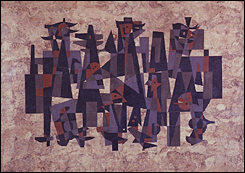
Movement
“The Indian”
A growing number of Latin American intellectuals and artists were dissatisfied with the conservative and materialistic values of Western society. They joined in a search for a revitalized art more responsive to social needs. Many joined struggles for social justice and educational and economic reforms. The Mexican muralists were at the forefront of those artists who believed that art should serve social and political needs.
Close bonds arose among artists, poets, and musicians. In 1922, Brazilian modernists held the Semana de Arte Moderna (Modern Art Week) which included exhibitions, poetry readings, and concerts. The Peruvian journal Amauta linked avant-garde artists and writers to revolutionary politics. Writer Jorge Luis Borges and artist Xul Solar contributed to the modernist review Martín Fierro in Argentina.